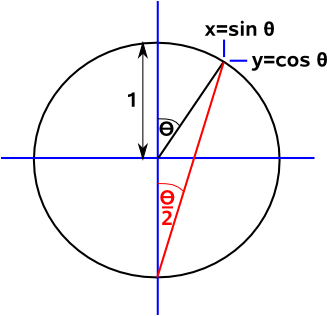Applications
These functions are very useful in geometry of course. However they are widely used in mathematics, physics and engineering.
Right Angle Triangle
The sine, cosine and tangent functions represent how the ratio of the sides of a right angled triangle varies with the angle. These can be defined by a right angled triangle in two dimensions as follows:
Let:
|
 |
The ratio of these lengths depends on the angle θ and we can define the following functions for each of the ratios:
| sine function | sin(θ) = b / a | |
| cosine function | cos(θ) = c / a | |
| tangent function | tan(θ) = b / c | |
| cosecant | cosec(θ) = a / b | |
| secant | sec(θ) = a / c | |
| cotangent | cot(θ) = c / b |
these functions are related to each other as follows:
tan(θ) = sin(θ) / cos(θ)
cosec(θ) = 1 / sin(θ)
sec(θ) = 1 / cos(θ)
cot(θ) = 1 / tan(θ)
Terminology and Notation
The angle
The angle being considered is usually denoted by the greek letter theta: θ. We can also denote the angle by three points which define that angle, for example in the above diagram: θ = ABC Where the middle point is where the angle is measured between the other two points. |
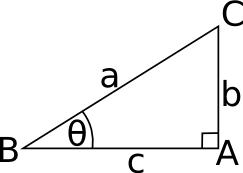 |
The sides
The sides can be denoted in different ways:
- we often use the names: hypotenuse, opposite and adjacent.
- we could use the letters a,b and c
- we could use the upper case letters for the two points the line connects: AB, BC and AC.
| hypotenuse - the side opposite the right angle | a | BC |
| opposite - the side opposite the angle being considered | b | AC |
| adjacent - the side adjacent to the angle being considered | c | AB |
The Vertices
The points of the triangle, the vertices, are here denoted by upper case letters A,B and C
The Trig Functions
The main trigometric functions are: sine, cosine and tangent. These are often abbreviated to sin, cos and tan.
There are three others cosecant, secant and cotangent . They not used so often because they are the reciprocal of sine, cosine and tangent. They are abbreviated to cosec, sec and cot.
Trig Identities
The values of sin, cos and tan are related to each other, for instance,
- tan A = sin A / cos A
- cos2A + sin2A = 1
These 'identities' can be proved by using the sides of a right angled triangle as follows:
tan A = b / c = (b / a) / (c / a) = sin A/cos A
From Pythagoras we know:
b2 + c2 = a2
dividing both sides by a2 gives:
b2 / a2 + c2 / a2 = 1
cos2A + sin2A = 1
Complimentary and Supplementary Angles
Two angles whose sum is 90° are said to be complimentary, each is said to be the compliment of the other. Where the sum is 180° the angles are said to be supplementary.
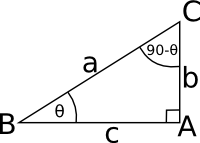 |
sin(θ - 90°) = BA / BC = cos(θ) cos(θ - 90°) = AC / BC = sin(θ) tan(θ - 90°) = AC / AB = cot(θ) |
Non-Right Angled Triangles - The Sine Rule
We started with right angled triangles but we can also use trig functions for other triangles:
Acute angled triangle
Drop a perpendicular from A to BC and let AD = h, then, sin B = h / c h = c sin B similarly, sin C = h / b h = b sin C |
 |
combining these gives:
c sin B = b sin C
so,
b / sin B = c / sin C
similarly if we put a perpendicular from B onto AC we can show that:
a / sin A = c / sin C
So, combining these, we get:
a / sin A = b / sin B = c / sin C
where:
- sin A = the sine of the angle at corner A
- sin B = the sine of the angle at corner B
- sin C = the sine of the angle at corner C
- a = length of side a
- b = length of side b
- c = length of side c
Obtuse angled triangle
This time we need to extend the line from B to C onto D so that it can meet a perpendicular from A. sin B = h / c h = c sin B similarly, sin ACD = h / b h = b sin ACD |
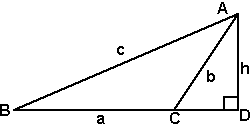 |
combining these gives:
c sin B = b sin ACD
but sin ACD = sin(180° - ACD) = sin c
so,
b / sin B = c / sin C
similarly if we put a perpendicular from B onto AC we can show that:
a / sin A = c / sin C
So, combining these, we get:
a / sin A = b / sin B = c / sin C
where:
- sin A = the sine of the angle at corner A
- sin B = the sine of the angle at corner B
- sin C = the sine of the angle at corner C
- a = length of side a
- b = length of side b
- c = length of side c
Example 1
solve triangle ABC if:
- A = 70°
- C = 58°16'
- b = 6m
Angles of triangle add up to 180° so,
B = 180° - (70° + 58°16')
B = 51°74'
since: a / sin A = b / sin B then,
a = b * sin A/ sin B
a = 6m * sin 70°/ sin 51°74'
a = 6.63m
Example 2
solve triangle ABC if:
- c = 85.3
- b = 70.25
- B = 40°
b / sin B = c / sin C
sin C = sin B * c / b
C = 51°44'
however this is an ambiguous case since there is also a solution at sin(180°-51°19')
Non-Right Angled Triangles - The Cosine Rule
We can use this to solve for triangles where the sine rule is not applicable (when we know 2 sides and the included angle). We create a perpendicular to the side b, mark the point this joins as D. |
 |
We can apply Pythagoras to the two inner triangles:
h2 = c2 - n2
a2 = (b-n)2 - h2
expanding the second one, and substitute the first for h, gives:
a2 = b2 - 2bn + n2+ c2 - n2
a2 = b2 - 2bn + c2 but n = c cos A which gives,
a2 = b2 + c2 - 2*b*c*cos A
we can do similar constructions based on the other sides:
b2 = c 2 + a 2 - 2*c*a*cos B
c2 = a 2 + b 2 - 2*a*b*cos C
rearranging these equations gives:
cos A = (b2 + c2 - a2)/2*b*c
cos B = (c2 + a 2 - b 2)/2*c*a
cos C = (a2 + b 2 - c 2)/2*a*b
Area of triangles
The area of a triangle is: 1/2 base * perpendicular height
therefore: area = 1/2 a * h but h = c*sin B therefore, area = 1/2 a * c*sin B |
 |
similarly we can do the same construction for the other sides:
area = 1/2 a * b*sin C
area = 1/2 b * c*sin A
This is half the product of two sides and the sin of the included angle.
Addition Formulae
We want to express sin(A+B) in terms of trig ratios
sin(A+B)
From the diagram we can see that the area of the whole is equal to the sum of the areas of the inner triangles: area LMP = area LMN + area LNP 0.5 p m sin(A+B) = 0.5 n p sin A + 0.5 m n sin B |
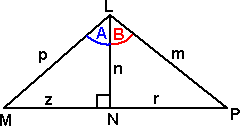 |
which gives:
sin(A+B) = (n/m) sin A + (n/p) sin B
but n/m = cos B and n/p = cos A
substituting these gives:
sin(A+B) = sin A cos B + cos A sin B
cos(A+B)
apply cos rule:
cos(A+B) = (p2 + m2 - (q+r)2)/2*m*p
cos(A+B) = (p2 + m2 - q2- 2*q*r- r2)/2*m*p
cos(A+B) = ((p2 - q2)+(m2 - r2)- 2*q*r) / 2*m*p
cos(A+B) = (n2+n2- 2*q*r) / 2*m*p
cos(A+B) = (n2- q*r) / m*p
cos(A+B) = n2/m*p - q*r/m*p
cos(A+B) = n/p * n/m - q/p * r/m
cos(A+B) = cos A cos B - sin A sin B
tan(A+B)
tan(A+B) = sin(A+B)/cos(A+B)
tan(A+B) = (sin A cos B + cos A sin B)/(cos A cos B - sin A sin B)
divide top & bottom by cos A cos B
tan(A+B) = ((sin A cos B/cos A cos B) + (cos A sin B/cos A cos B))/((cos A cos B/cos A cos B) - (sin A sin B/cos A cos B))
tan(A+B) = ((sin A /cos A) + (sin B/cos B))/(1 - (sin A sin B/cos A cos B))
tan(A+B) = (tan A + tan B)/(1 - tan A tan B)
Double Angle Formulae
from addition formulae if A=B
- sin(2A) = 2 sin A cos A
- cos(2A) = cos2A - sin2A = 1 - 2*sin2A
- tan(2A) = 2 tan A/(1 - tan2A)
The second form of the cos(2A) formula can be proved as follows:
from the addition formulae if A=B we get:
cos(2A) = cos2A - sin2A
but we can combine this with the identity:
cos2A + sin2A = 1
substituting
cos(2A) = (1 - sin2A) - sin2A
cos(2A) = 1 - 2*sin2A
I have put further information about double angle and half angle formulae on the page here.
Subtraction formulae
from addition formulae if A=B
- sin(A-B) = sin A cos B - cos A sin B
- cos(A-B) = cos A cos B + sin A sin B
- tan(A-B) = (tan A - tan B)/(1 + tan A tan B)
Angles of Any Magnitude
So far we have defined the trig functions using right angled triangles and therefore used angles between 0 and 90 degrees however we can extend the concept of sine, cosine, etc. and use angles beyond that range. If we plot the angle (![]() ) across (left to right) and the ratio of sides up (bottom to top) then we get a wave-like function like this which repeats continuously in both directions:
) across (left to right) and the ratio of sides up (bottom to top) then we get a wave-like function like this which repeats continuously in both directions:
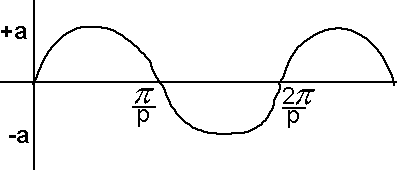
Angle Sign
If ![]() is formed by OP rotating about O and rotation is anticlockwise
is formed by OP rotating about O and rotation is anticlockwise ![]() is said to be positive. If clockwise
is said to be positive. If clockwise ![]() is said to be negative.
is said to be negative.

Results
Because the trig functions repeat like this, we can derive the values outside 0°-90° from the values inside the 0°-90° range.
- sin(180° - θ) = sin(θ)
- sin(180° + θ) = -sin(θ)
- cos(90° + θ) = -sin(θ)
- cos(90° - θ) = sin(θ)
- tan(270° + θ) = -cotan(θ)
- tan(270° - θ) = cotan(θ)
- sec(180° + θ) = -sec(θ)
- cosec(180° - θ) = cosec(θ)
- cot(360° + θ) = cot(θ)
- sin(360° - θ) = -sin(θ)
- cos(270° + θ) = sin(θ)
- cos(270° - θ) =
Quadrants
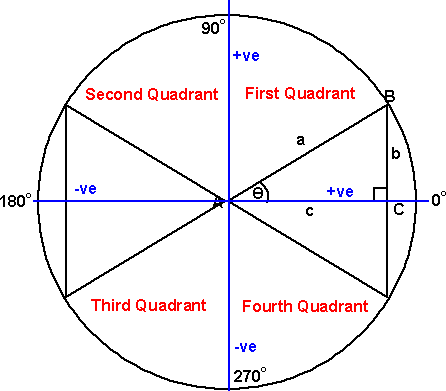
First Quadrant
In the first quadrant, angles between 0° and 90°, both the x axis and the y axis are positive, therefore the ratios are positive, and all the trig functions are positive.
Second Quadrant
In the second quadrant, angles between 90 ° and 180°, the x axis is negative and the y axis is positive, therefore:
| sine function | sin(θ) = b(+ve) / a(+ve) = (+ve) | |
| cosine function | cos(θ) = c(-ve) / a(+ve) = (-ve) | |
| tangent function | tan(θ) = b(+ve) / c(-ve) = (-ve) | |
| cosecant | cosec(θ) = a(+ve) / b(+ve) = (+ve) | |
| secant | sec(θ) = a(+ve) / c(-ve) = (-ve) | |
| cotangent | cot(θ) = c(-ve) / b(+ve) = (-ve) |
Third Quadrant
In the first quadrant, angles between 180° and 270°, both the x axis and the y axis are negative, therefore:
| sine function | sin(θ) = b(-ve) / a(+ve) = (-ve) | |
| cosine function | cos(θ) = c(-ve) / a(+ve) = (-ve) | |
| tangent function | tan(θ) = b(-ve) / c(-ve) = (+ve) | |
| cosecant | cosec(θ) = a(+ve) / b(-ve) = (-ve) | |
| secant | sec(θ) = a(+ve) / c(-ve) = (-ve) | |
| cotangent | cot(θ) = c(-ve) / b(-ve) = (+ve) |
Fourth Quadrant
In the second quadrant, angles between 270 ° and 360°, the x axis is negative and the y axis is positive, therefore:
| sine function | sin(θ) = b(-ve) / a(+ve) = (-ve) | |
| cosine function | cos(θ) = c(+ve) / a(+ve) = (+ve) | |
| tangent function | tan(θ) = b(-ve) / c(+ve) = (-ve) | |
| cosecant | cosec(θ) = a(+ve) / b(-ve) = (-ve) | |
| secant | sec(θ) = a(+ve) / c(+ve) = (+ve) | |
| cotangent | cot(θ) = c(+ve) / b(-ve) = (-ve) |

